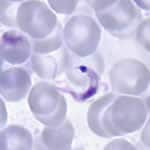
Trypanosomiasis

Chagas disease is named after the Brazilian physician Carlos Chagas, who discovered the disease in 1909. It is caused by the parasite Trypanosoma cruzi, which is transmitted to animals and people by insect vectors and is found only in the Americas (mainly, in rural areas of Latin America where poverty is widespread). Chagas disease (T. cruzi infection) is also referred to as American trypanosomiasis.
Diagnosis

Trypansoma cruzi parasite in a thin blood smear. Credit: DPDx
During the acute phase of infection, parasites may be seen circulating in the blood. The diagnosis of Chagas disease can be made by observation of the parasite in a blood smear by microscopic examination. A thick and thin blood smear are made and stained for visualization of parasites.
Treatment
Treatment for Chagas disease is recommended for people diagnosed early in the course of infection (acute phase), babies with congenital infection, and for those with suppressed immune systems. Many patients with chronic infection may also benefit from treatment.
Patients should consult with their primary health-care provider. Some patients may be referred to a specialist, such as a cardiologist, gastroenterologist, or infectious disease specialist.
Your health-care provider can talk with CDC staff about treatment options for Chagas disease.